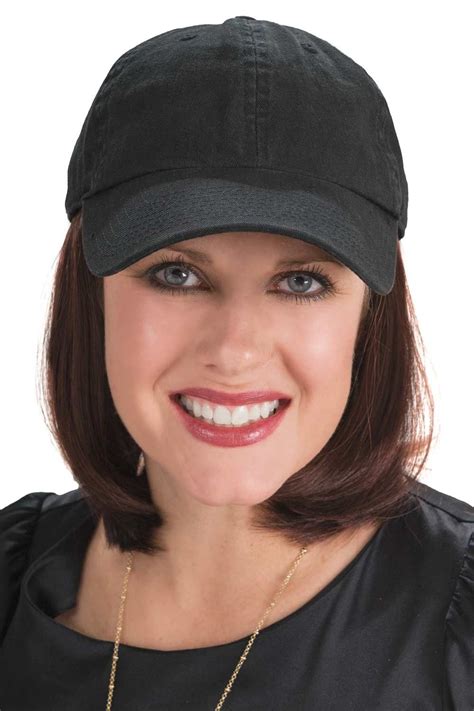Introduction
Caps with hair attached offer a stylish and convenient solution for people who want to enhance their appearance or conceal hair loss. With the growing popularity of these accessories, we delve into the world of caps with hair attached, exploring their types, benefits, and innovative applications.

Types of Caps with Hair Attached
1. Snap-On Hair Toppers
Snap-on hair toppers are semi-permanent hairpieces that attach to the top of the head using pressure-sensitive clips. They provide instant volume and coverage for thinning hair or areas of hair loss.
2. Clip-In Hair Extensions
Clip-in hair extensions are individual hair wefts that can be attached and removed as desired. They offer versatility in terms of length, color, and style, allowing for customized hair transformations.
3. Base Bump Hairpieces
Base bump hairpieces are designed to create a natural-looking bump or volume at the crown of the head. They integrate seamlessly with existing hair, providing lift and coverage.
4. Full-Cap Wigs
Full-cap wigs cover the entire head, providing maximum coverage and a complete hair transformation. They are ideal for individuals with extensive hair loss or who desire a different hair color or style.
Benefits of Caps with Hair Attached
1. Instant Volume and Coverage
Caps with hair attached instantly add volume and fullness to thinning hair, concealing areas of hair loss or baldness. They provide a quick and effective solution to enhance one’s appearance.
2. Versatile Styling Options
Many caps with hair attached come in various colors, lengths, and styles, offering a wide range of options to match natural hair or create desired looks. They allow for versatile styling and customization.
3. Non-Surgical Hair Replacement
Caps with hair attached offer a non-surgical alternative to hair transplants or other invasive procedures. They provide a convenient and affordable solution for hair loss or the desire to experiment with different hairstyles.
4. Enhanced Confidence
By improving one’s appearance, caps with hair attached can boost confidence and self-esteem. They empower individuals to feel more attractive and at ease with their hair.
Innovative Applications of Caps with Hair Attached
1. Hair Loss Concealment
Caps with hair attached offer a discreet solution to conceal hair loss caused by medical conditions, aging, or genetic factors. They provide a comfortable and realistic alternative to traditional wigs or toupees.
2. Protective Hairstyles
Caps with hair attached can be worn under other hairstyles, such as scarves, hats, or head coverings. This protective layer shields the hair from the elements and minimizes damage caused by friction or heat styling.
3. Hair Fashion and Experimentation
Caps with hair attached allow for temporary hair transformations, providing a risk-free way to experiment with different colors, lengths, and styles. They cater to individuals who enjoy changing their appearance without committing to long-term changes.
4. Medical Applications
Caps with hair attached have found applications in medical settings, such as concealing hair loss during cancer treatments or providing warmth and comfort for burn victims. They offer a practical and compassionate solution to support patients’ well-being.
Market Statistics and Trends
According to a report by Grand View Research, the global market for hair extensions and wigs is projected to reach $10.5 billion by 2027, with a CAGR of 6.7%. This growth is attributed to increasing demand for non-surgical hair replacement solutions and the growing popularity of hair fashion and experimentation.
Strategies for Selecting the Right Cap with Hair Attached
1. Determine Hair Type and Loss
Assess your natural hair type and the extent of hair loss to choose a cap that matches your needs. Consider the length, texture, and color of your existing hair.
2. Explore Different Types
Research the various types of caps with hair attached, including snap-on hair toppers, clip-in hair extensions, base bump hairpieces, and full-cap wigs. Consider the desired level of coverage, versatility, and styling options.
3. Seek Professional Advice
Consult with a hair stylist or a hair loss specialist to assess your specific needs and recommend suitable solutions. They can provide expert guidance and ensure a comfortable and natural-looking fit.
4. Consider Quality and Materials
Invest in high-quality caps with hair attached made from natural-looking materials. Synthetic fibers can be prone to tangling and heat damage, while human hair offers a more realistic and durable option.
Tips and Tricks for Using Caps with Hair Attached
1. Maintain and Care
Follow the manufacturer’s instructions for proper maintenance of your cap with hair attached. This includes brushing, washing, and conditioning the hair to prevent tangles and maintain its appearance.
2. Secure Attachment
Ensure a secure attachment of your cap to prevent slippage or movement throughout the day. Use hair clips, bobby pins, or adhesive tape as needed to keep it in place.
3. Blend Hair Seamlessly
To blend your natural hair seamlessly with the cap, use small sections of hair from your crown and weave them over the cap’s edge. This creates a natural-looking transition.
4. Style and Accessorize
Caps with hair attached offer endless styling possibilities. Experiment with different hairstyles and accessorize with hats, scarves, or hair jewelry to complement your look.
Conclusion
Caps with hair attached represent a cutting-edge solution for enhancing appearance, concealing hair loss, and exploring hair fashion. They offer a wide range of options to suit individual needs and preferences. By embracing the benefits of caps with hair attached, you can unlock new possibilities for expressing your confidence and style.
